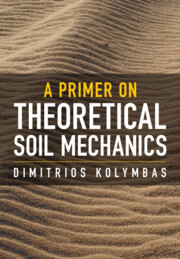Book contents
- Frontmatter
- Contents
- Preface
- 1 Granular Materials as Soft Solids
- 2 Mechanical Behaviour of Soil: Experimental Results
- 3 Mechanical Behaviour of Soil: Intuitively
- 4 Vectors and Tensors
- 5 Fields
- 6 Deformation
- 7 Stress
- 8 Conservation Laws (Balance Equations)
- 9 Internal Friction and Shear Strength
- 10 Collapse
- 11 Constitutive Equations
- 12 Elasticity
- 13 ElasticWaves
- 14 Plasticity Theory
- 15 Hypoplasticity
- 16 Barodesy
- 17 Uniqueness
- 18 Symmetry
- 19 Interaction with Water
- 20 Computing in Soil Mechanics
- 21 Outlook
- References
- Index
17 - Uniqueness
Published online by Cambridge University Press: 14 July 2022
- Frontmatter
- Contents
- Preface
- 1 Granular Materials as Soft Solids
- 2 Mechanical Behaviour of Soil: Experimental Results
- 3 Mechanical Behaviour of Soil: Intuitively
- 4 Vectors and Tensors
- 5 Fields
- 6 Deformation
- 7 Stress
- 8 Conservation Laws (Balance Equations)
- 9 Internal Friction and Shear Strength
- 10 Collapse
- 11 Constitutive Equations
- 12 Elasticity
- 13 ElasticWaves
- 14 Plasticity Theory
- 15 Hypoplasticity
- 16 Barodesy
- 17 Uniqueness
- 18 Symmetry
- 19 Interaction with Water
- 20 Computing in Soil Mechanics
- 21 Outlook
- References
- Index
Summary
The problem of uniqueness in solving initial boundary value problems is considered together with its implications for the simulation of element tests. Some general theorems holding for linear constitutive equations are discussed together with some applications to soil. The formation of shear bands ('faults’ in geology) is described as a special case of loss of uniqueness. Vortices are also introduced as patterns of loss of uniqueness.
- Type
- Chapter
- Information
- A Primer on Theoretical Soil Mechanics , pp. 136 - 140Publisher: Cambridge University PressPrint publication year: 2022

